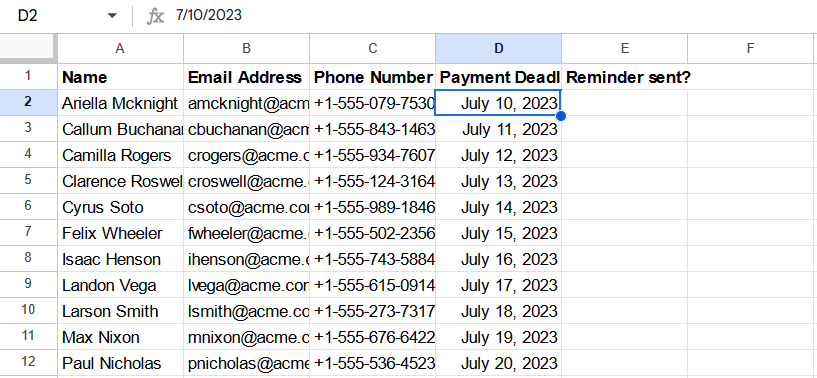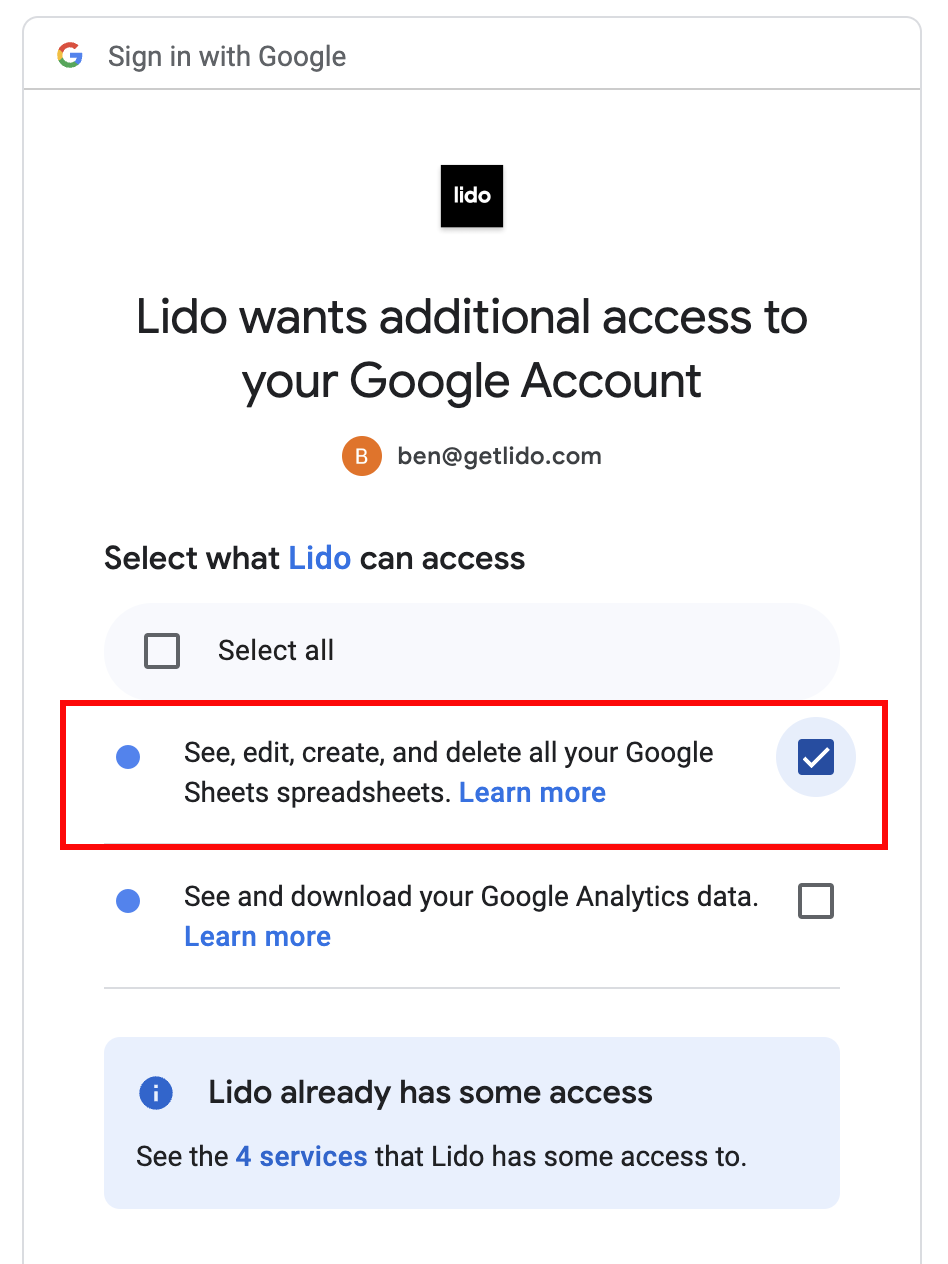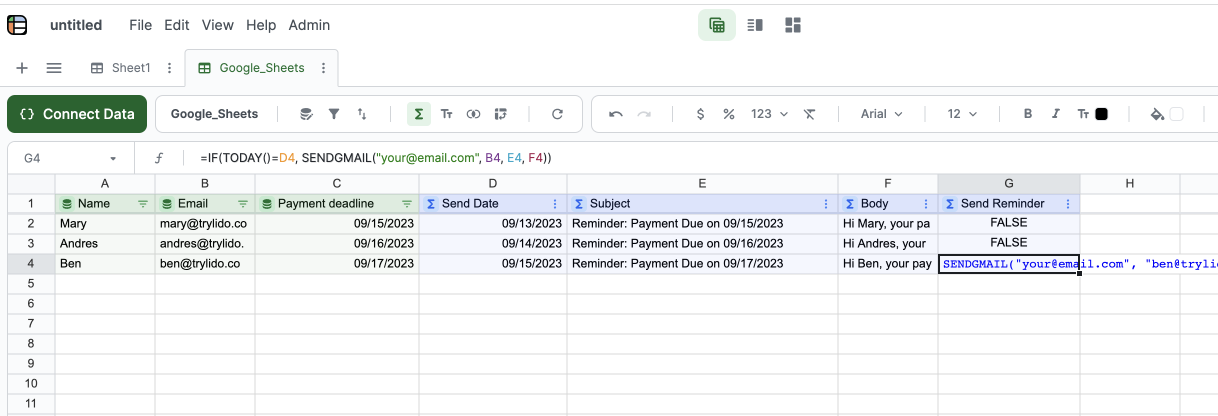There is no native reminder function in Google Sheets. However you can easily import your Google Sheet into a Lido spreadsheet and you can set up reminders emails in just a few clicks.
Make sure your Google Sheet is formatted like our sample sheet here:

Copy the URL for your Google Sheet. We'll need this to connect your spreadsheet to Lido.




Reminders are supposed to be sent ahead of the deadline. For our example, we will send reminders two days before the deadline.


We are now ready to add the subject and body of the reminder email.

Now we need to combine these templates with our table in order to make the content dynamic. We'll do that by creating two new computed columns for both Subject and Body. We will use a formula called STRINGTEMPLATE() inside of a computed column to do this.


Your sheet should now look like this:

Unlike Google Sheets, Lido's spreadsheet has a special type of formula called Action formulas. SENDGMAIL() is an Action formula.
SENDGMAIL works as follows:
=SENDGMAIL(sender, recipient, subject, body, [status_cell], [cc], [bcc], [attachments])
Where:
sender-credential - a credential you create for your@email.com (This should be associated with a Gmail or Google Apps account)
recipient - the email of the user that will receive the reminder
subject - the email subject
body - the email body
In our example, the core SENDGMAIL formula looks like:
You'll need to add a SENDGMAIL credential to connect your Gmail account to Lido. To do this, start typing =SENDGMAIL(
When you're in the first argument, click on the "+Add credential" to add a sender credential to your Gmail (or Google Apps) account.

If we want to have SENDGMAIL display only when today's date is the reminder send date, then we want to add an IF statement:
=IF(TODAY() = reminder_send_date, SENDGMAIL(sender-credential, recipient, subject, body))
The formula works as follows:
If today's date is equal to the reminder_send_date, then display the SENDGMAIL formula, otherwise display FALSE.
Let's create a new computed column, and enter our formula below in row 2 (adjust the formula for your data). We can double click on the header cell, and rename the column to Send Reminder.

As you can see, the SENDGMAIL formula is only visible for dates when Send Date = Today. For all other days it displays FALSE.
Right click on the SENDGMAIL formula and click "Run Action" to send the email.

Now, we can automate the running of the Send Reminder column. For rows where SENDGMAIL displays in the column, Lido can automatically run them once per day, even if the file is closed.
Click on your Send Reminder column menu and select Run column on a schedule.

Select what time of day you want your messages to send, then click save.
.png)
Now, every day at 1:15PM (or whatever time you've selected), Lido will pull in the latest records from your Googlle sheet, automatically check and see if there are any reminder emails that need to be sent where TODAY = reminder_send_date, and if so, run the each SENDGMAIL formula and send the emails.

Impressed? Click here to get started with Lido!
Easy. In the Step 3 above, just change the number in the formula. For the example that we use, we have the following formula:
=C2-2
This will send the reminder two days before the deadline. To send the reminder a week before the deadline, just change the number to 7 (7 days):
=C2-7
If instead you want to send the reminder 3 days before the deadline, just change it to 3:
=C2-3
And so on.
You can check if the formula works first before setting the automation settings. First, change the sender_email and recipient_email to the one you can open. Afterwards, click the cell containing the formula for sending reminder emails. Then, click right click on the SENDGMAIL formula and select Run action.

Lido will run the formula. If the formula has no errors, the message Action run successfully will appear on the lower-right corner of Lido.

You can also send reminders a few times at different times to the same user. You just need to repeat the Steps 3 to 6, adding a set of columns for each instance.
To set a reminder in google sheets, simply add a SENDGMAIL formula to your sheet and set the time and date you want your email reminder to send. It's that simple to create a google sheets reminder!
If you enjoyed this article, check out our article on how to set up bulk email from google sheets or send email based on a date in google sheets.